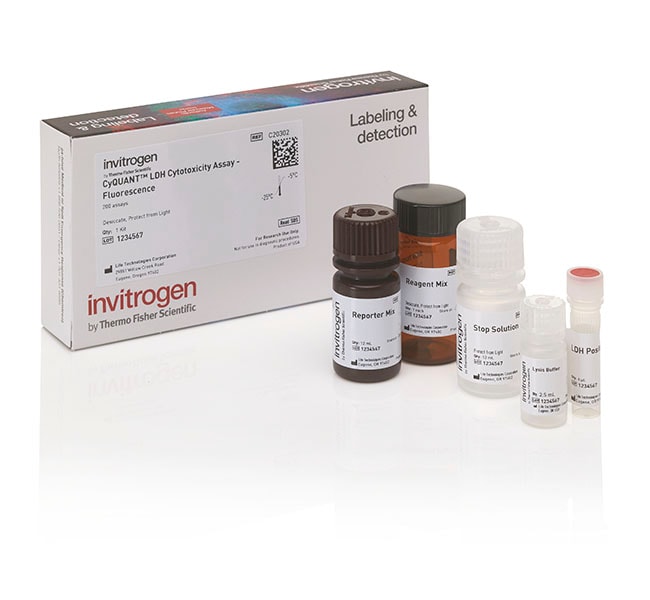Search

CyQUANT™ LDH and G6PD Cytotoxicity Assays
| 產品號碼 | Quantity | Emission |
|---|---|---|
| C20302 | 200 Assays | 590 nm |
| C20300 | 200 Assays | 490 nm |
| C20301 | 1000 Assays | 490 nm |
| C20303 | 1000 Assays | 590 nm |
| V23111 | 1 Kit | 587 nm |
CyQUANT cytotoxicity assays provide a simple and reliable method to assess chemical or cell-mediated cellular toxicity. The CyQUANT LDH Cytotoxicity Assays and the CyQUANT Cytotoxicity Assay (G6PD Release Assay) use colorimetric- or fluorescence-based detection to measure the release of cytosolic enzymes (LDH or G6PD) from damaged cells. These cytotoxicity assays are optimized for use on microplate readers and can be used for continuous monitoring of cell health over time since cell lysis is not required, making them versatile tools for high-throughput screening and drug discovery applications.
CyQUANT LDH cytotoxicity assays
CyQUANT LDH Cytotoxicity Assays (Cat. Nos. C20300 and C20301) are used to measure cytotoxicity through the release of lactate dehydrogenase (LDH), a proven indicator of cellular toxicity. LDH is a cytosolic enzyme found in many cells that is released into the surrounding cell culture medium when the plasma membrane is damaged due to cellular injury, tissue damage, or disease. CyQUANT LDH Assays enable accurate and quantitative measurement of this extracellular LDH release using either colorimetric or fluorescence detection on microplate readers. These LDH assay kits can be used with different cell types, including 3D cell models. Since LDH released into the medium is the indicator of cytotoxicity, these assays can monitor cellular toxicity from the same sample over time.
Features of the CyQUANT LDH Cytotoxicity Assay
- Convenient—add-mix-read format for adherent and suspension cells, including 3D cell models
- Accurate—provides a quantitative measurement of LDH release
- Flexible—ideal for high-throughput screening, monitor cytotoxicity from the same sample over time
- Robust—uses stable LDH enzyme activity as a cytotoxic marker
Mechanism and protocol for the colorimetric CyQUANT LDH Cytotoxicity Assay
In the colorimetric CyQUANT LDH Assay (Cat. Nos. C20300 and C20301), extracellular LDH release is quantified by a coupled enzymatic reaction in which LDH catalyzes the conversion of lactate to pyruvate via NAD+ reduction to NADH. Diaphorase then uses NADH to reduce a tetrazolium salt (INT) to a red formazan product that can be measured at 490 nm. The level of formazan formation and absorbance is directly proportional to the amount of LDH released into the medium. To perform this LDH release assay, an aliquot of the cell culture medium is transferred to a new plate and the reaction mixture is added. After a 30-minute incubation, the reaction is stopped by adding Stop Solution and absorbance is measured using a microplate reader.
Note: The CyQUANT LDH Cytotoxicity Assay is a direct replacements for the Pierce LDH Cytotoxicity Assay Kit (Cat. Nos. 88953 and 88954).
Mechanism and protocol for the fluorescence CyQUANT LDH Cytotoxicity Assay
In the fluorescence CyQUANT LDH Assay (Cat. Nos. C20302 and C20303), extracellular LDH release is quantified by a coupled enzymatic reaction in which LDH catalyzes the conversion of lactate to pyruvate via NAD+ reduction to NADH. Diaphorase then uses NADH to reduce resazurin to resorufin that can be detected using an ex/em of 560/590 nm using a fluorescence microplate reader. The level of resorufin formation and fluorescence is directly proportional to the amount of LDH released into the medium.
The fluorescence CyQUANT LDH Assay uses highly purified resazurin to increase assay sensitivity and dynamic range. Our innovative manufacturing process removes contaminating resorufin, which contributes to background fluorescence, resulting in the highly pure resazurin included in the kit.
To perform this LDH release assay, an aliquot of the cell culture medium is transferred to a new plate and the reaction mixture is added. After a 10-minute incubation, the reaction is stopped by adding Stop Solution and fluorescence is measured using a microplate reader.
Features of the CyQUANT Cytotoxicity Assay Kit (G6PD Release Assay)
- High sensitivity—detects as few as 500 cells, offering greater sensitivity than LDH release assays
- Specific detection—measures glucose 6-phosphate dehydrogenase (G6PD) release from damaged and dying cells
- Low background signals—produces lower background fluorescence compared to LDH release assays
- Accurate and reliable—the fluorescence signal (ex/em 563/587 nm) is proportional to the number of dead cells, ensuring accurate cytotoxicity measurement
Mechanism and procedure for the CyQUANT Cytotoxicity Assay Kit (G6PD Release Assay)
The CyQUANT Cytotoxicity Assay (Cat. No. V23111) detects damaged and dying cells through the release of glucose 6-phosphate dehydrogenase (G6PD) into the surrounding medium. G6PD is an enzyme that plays a crucial role in the pentose phosphate pathway, generating NADPH to protect cells from oxidative damage and support fatty acid synthesis. This G6PD release assay can detect as few as 500 cells and is more sensitive than LDH release assays.
This cytotoxicity assay detects G6PD through a two-step enzymatic process. Oxidation of glucose 6-phosphate by G6PD generates NADPH, which leads to the reduction of resazurin by diaphorase to red-fluorescent resorufin. The resulting fluorescence signal is proportional to the amount of G6PD released into the cell medium and correlates with the number of dead cells in the sample. The fluorescence of resorufin (ex/em 563/587 nm) is beyond the autofluorescence of most biological samples and can be detected in fluorescence microplate readers. This G6PD assay results in lower background signals than are typically observed in LDH assays, offering increased sensitivity.
• 1 x 12 mL Reporter Mix
• 1 x 2.5 mL Lysis Buffer
• 1 x 12 mL Stop Solution
• 1 x 6 μL LDH Positive Control
Store at -20°C, protect from light.